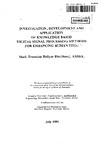INVESTIGATION, DEVELOPMENT AND APPLICATION OF KNOWLEDGE BASED DIGITAL SIGNAL PROCESSING METHODS FOR ENHANCING HUMAN EEGsJ
| dc.contributor.author | Hellyar, Mark Tremaine | |
| dc.contributor.other | School of Engineering, Computing and Mathematics | en_US |
| dc.date.accessioned | 2013-09-18T09:08:48Z | |
| dc.date.available | 2013-09-18T09:08:48Z | |
| dc.date.issued | 1991 | |
| dc.identifier | NOT AVAILABLE | en_US |
| dc.identifier.uri | http://hdl.handle.net/10026.1/1820 | |
| dc.description.abstract |
This thesis details the development of new and reliable techniques for enhancing the human Electroencephalogram {EEGI. This development has involved the incorporation of adaptive signal processing (ASP) techniques, within an artificial intelligence (Al) paradigm, more closely matching the implicit signal analysis capabilities of the EEG expert. The need for EEG enhancement, by removal of ocular artefact (OA) , is widely recognised. However, conventional ASP techniques for OA removal fail to differentiate between OAs and some abnormal cerebral waveforms, such as frontal slow waves. OA removal often results in the corruption of these diagnostically important cerebral waveforms. However, the experienced EEG expert is often able to differentiate between OA and abnormal slow waveforms, and between different types of OA. This EEG expert knowledge is integrated with selectable adaptive filters in an intelligent OA removal system (tOARS). The EEG is enhanced by only removing OA when OA is identified, and by applying the OA removal algorithm pre-set for the specific OA type. Extensive EEG data acquisition has provided a database of abnormal EEG recordings from over 50 patients, exhibiting a variety of cerebral abnormalities. Structured knowledge elicitation has provided over 60 production rules for OA identification in the presence of abnormal frontal slow waveforms, and for distinguishing between OA types. The lOARS was implemented on personal computer (PCI based hardware in PROLOG and C software languages. 2-second, 18-channel, EEG signal segments are subjected to digital signal processing, to extract salient features from time, frequency, and contextual domains. OA is identified using a forward/backward hybrid inference engine, with uncertainty management, using the elicited expert rules and extracted signal features. Evaluation of the system has been carried out using both normal and abnormal patient EEGs, and this shows a high agreement (82.7%) in OA identification between the lOARS and an EEG expert. This novel development provides a significant improvement in OA removal, and EEG signal enhancement, and will allow more reliable automated EEG analysis. The investigation detailed in this thesis has led to 4 papers, including one in a special proceedings of the lEE, and been subject to several review articles. | en_US |
| dc.description.sponsorship | Department of Neurophysiology, Derriford Hospital, Plymouth, Devon | en_US |
| dc.language.iso | en | en_US |
| dc.publisher | University of Plymouth | en_US |
| dc.title | INVESTIGATION, DEVELOPMENT AND APPLICATION OF KNOWLEDGE BASED DIGITAL SIGNAL PROCESSING METHODS FOR ENHANCING HUMAN EEGsJ | en_US |
| dc.type | Thesis | |
| plymouth.version | Full version | en_US |
| dc.identifier.doi | http://dx.doi.org/10.24382/4701 | |
| dc.identifier.doi | http://dx.doi.org/10.24382/4701 |
Files in this item
This item appears in the following Collection(s)
-
01 Research Theses Main Collection
Research Theses Main


